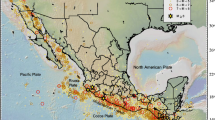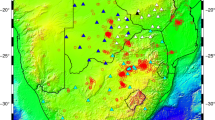Abstract
In the present paper, the parameters affecting the uncertainties on the estimation of M max have been investigated by exploring different methodologies being used in the analysis of seismicity catalogue and estimation of seismicity parameters. A critical issue to be addressed before any scientific analysis is to assess the quality, consistency, and homogeneity of the data. The empirical relationships between different magnitude scales have been used for conversions for homogenization of seismicity catalogues to be used for further seismic hazard assessment studies. An endeavour has been made to quantify the uncertainties due to magnitude conversions and the seismic hazard parameters are then estimated using different methods to consider the epistemic uncertainty in the process. The study area chosen is around Delhi. The b value and the magnitude of completeness for the four seismogenic sources considered around Delhi varied more than 40% using the three catalogues compiled based on different magnitude conversion relationships. The effect of the uncertainties has been then shown on the estimation of M max and the probabilities of occurrence of different magnitudes. It has been emphasized to consider the uncertainties and their quantification to carry out seismic hazard assessment and in turn the seismic microzonation.
Similar content being viewed by others
References
Aki K 1965 Maximum likelihood estimate of b in the formula log N = a - bM and its confidence limits; Bull. Earthq. Res. Inst. Tokyo Univ. 43 237–239.
Ameer S, Sharma M L, Wason H R and AlSinawi A 2005 Conversion of magnitudes for assessment of recurrence time in revised “Iraq seismicity catalogue”; Symposium on Seismic Hazard analysis and Microzonation, Roorkee India, September 23–24, 2005, 1 201–211.
Barnett V D 1967 A note on linear structural relationships when both residual variances are known; Biometika 54 670–672.
Bath M 1968 Handbook on earthquake magnitude determination, 2nd edn., Seismological Institute, Uppsala, 131.
Bommer J J, Scherbaum F, Bungum H, Cotton F, Sabetta F and Abrahamson N A 2005 On the use of logic trees for ground-motion prediction equations in seismic hazard analysis; Bull. Seismol. Soc. Am. 95(2) 377–389.
Cao A M and Gao S S 2002 Temporal variation of seismic b-values beneath northeastern Japan island arc; Geophys. Res. Lett. 29(9) 1–3.
Draper N R and Smith H 2005 Applied regression analysis, John Wiley & Sons (Asia) Pvt. Ltd.
Gibowicz S J 1972 The relationship between teleseismic body wave magnitude and local magnitude from New Zealand earthquakes; Bull. Seismol. Soc. Am. 62 1–10.
Gutenberg B and Richter C F 1956a Earthquake magnitude, intensity, energy and acceleration; Bull. Seismol. Soc. Am. 46 105–143.
Gutenberg B and Richter C F 1956b Magnitude and Energy of Earthquakes; Amm. Geofis. 9 1–15.
Joshi G C and Sharma M L 2006 Magnitude Scale conversion relationships for Northern Indian Region using bivariate analysis; 13th Symposium on Earthquake Engineering, Indian Institute of Technology, Roorkee, December 18–20, 2006. Paper 195.
Kijko A and Graham G 1998 “Parametric historic procedure for probabilistic seismic analysis, Part I: Estimation of maximum regional magnitude M max”; Pure Appl. Geophys. 152 413–442.
Kijko A and Sellevol M A 1989 “Estimation of earthquake hazard parameters from incomplete data files, Part I: Utilization of extreme and complete catalogues with different threshold magnitudes”; Bull. Seismol. Soc. Am. 40 1–7.
Kijko A and Sellevoll M A 2001 “Computer program HN2, RELEASE 2.08, 2001”, Seismology Unit; URL: http://www.geoscience.org.za/seismo/index.htm.
Marshal P D 1970 Spectral differences between earthquakes and underground explosions; Geophys. J-R Astr. Soc. 20 397–416.
McGuire R K 2004 Seismic Hazard and Risk Analysis; Risk Engineering, Inc. Boulder, Colorado, EERI.
McGuire R K and Shedlock K M 1981 Statistical uncertainties in seismic hazard evaluations in the United States; Bull. Seismol. Soc. Am. 71 1287–1308.
Ogata Y and Katsura K 1993 Analysis of temporal and spatial heterogeneity of magnitude frequency distribution inferred from earthquake catalogs; Geophys. J. Int. 113 727–738.
Prozorov and Hudson J A 1974 A study of magnitude difference MS-mb for the earthquakes; Geophys. J-R Astr. Soc. 39 551–564.
Richter C F 1935 An instrumental earthquake magnitude scale; Bull. Seismol. Soc. Am. 25 1–32.
Shi Y and Bolt B A 1982 The standard error of the magnitude-frequency b-value; Bull. Seismol. Soc. Am. 72 1667–1687.
Shrama M L, Wason H R and Dimri R 2003 “Seismic zonation of the Delhi region for Bedrock ground motion”; Pure Appl. Geophys. 160 2381–2398.
Sprent D and Dolby G R 1980 The geometric mean relationships; Biometrics 36 547–550.
Suckale J, Grünthal G and Regnier M C 2005 “Probabilistic Seismic Hazard Assessment for Vanuatu”, Scientific Technical Report STR 05/16 GeoForschungsZentrum, Potsdam.
Tavakoli B 2002 Sensitivity of seismic hazard evaluation to uncertainties determined from seismic source characterization; J. Seismol. 6 525–545.
Utsu T 1965 A method for determining the value of b in a formula log n = a - bm showing the magnitude frequency for earthquakes; Geophys. Bull. Hokkaido Univ. 13 99–103.
Utsu T 2002a Statiscal Features of Seismicity; International Handbook of Earthquake and Engineering Seismology 81A 719–732.
Utsu T 2002b Relationship between magnitude scales; International Handbook of Earthquake Engineering and Engineering Seismology 81A 733–795.
Wang M Y 1989 Likelihood estimation of a simple linear regression model when both variables have error; Biometrika 76 141–148.
Wiemer S and Wyss M 2000 Minimum magnitude of complete reporting in earthquake catalogues: example from Alaska, the Western United States, and Japan; Bull. Seismol. Soc. Am. 90 859–869.
Woessner J and Wiemer S 2005 Assessing the quality of earthquake catalogues: Estimating the magnitude of completeness and its uncertainty; Bull. Seismol. Soc. Am. 95(2) 684–698.
Author information
Authors and Affiliations
Corresponding author
Rights and permissions
About this article
Cite this article
Joshi, G.C., Sharma, M.L. Uncertainties in the estimation of M max . J Earth Syst Sci 117 (Suppl 2), 671–682 (2008). https://doi.org/10.1007/s12040-008-0063-5
Received:
Revised:
Accepted:
Published:
Issue Date:
DOI: https://doi.org/10.1007/s12040-008-0063-5




